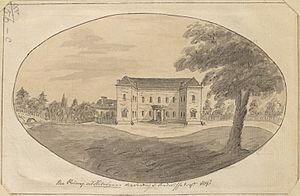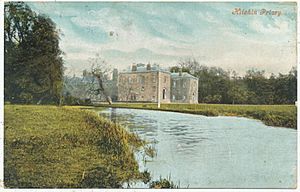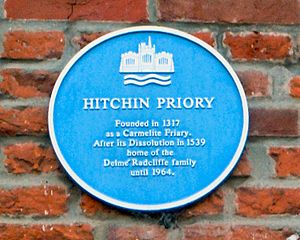Hitchin Priory facts for kids
Hitchin Priory is a beautiful old building in Hitchin, Hertfordshire. Today, it's a hotel, but it has a long and interesting history! It was built around the year 1700. Before that, it was the site of a Carmelite friary, which is like a home for a group of religious men called friars. This friary was started way back in 1317.
The friary closed down in the 1500s during a time called the Dissolution of the Monasteries. This happened when King Henry VIII was in charge. Some parts of the original friary are still part of the building you see today. Because it's so old and important, Hitchin Priory has been a special "Grade I listed" building since 1951. This means it's protected by Historic England because of its history.
Contents
A Look Back: The Priory's Beginnings
In 1317, King Edward II gave land in Hitchin to the Carmelite Friars. This was so they could build a church and a home for themselves. Other lands were also given to them by a person named John de Cobham.
The Carmelites built a small convent, which is another word for a religious community. They dedicated it to the Blessed Virgin Mary.
The Priory Closes Down
In 1530, King Henry VIII even gave the friars at Hitchin some money. However, things changed a few years later. In 1534, the leader of the friars, John Butler, had to take an important promise called the Oath of Supremacy. This oath said that the King was the head of the church, not the Pope.
Then, in 1538, John Butler and four other friars gave up their home to the King's representatives. The friars stayed until their house was officially closed in 1539. This was part of the big event known as the Dissolution of the Monasteries.
After the friars left, the priory was stripped down. Things like bells, lead, glass, and stone were taken away. The steeple was even knocked down! The old priory became a place where local people could take stone for their own buildings.
What the Priory Looked Like
In 1546, a survey was done to see what was left of the priory. The main house was still in good shape. But other parts, like the frater (dining hall) and dorter (dormitory) above the cloister (a covered walkway), were in bad condition. The church was also in ruins.
The survey said that most of the buildings were "very ruinous" (falling apart). The priory gardens were like "waste places of ground." The church was also in a poor state, with its steeple broken down and all its valuable materials gone.
New Owners and Rebuilding
After the survey, Hitchin Priory was sold in 1546 for a large sum of money. It was bought by two people who bought and sold properties: Sir Edward Watson and Henry Herdson.
From them, the priory was sold to Edward Pulter, and then in 1582, to Ralph Radcliffe. Over the next 300 years, the Priory stayed in the Radcliffe family. Different members of the Delmé-Radcliffe Family owned it from 1582 until 1964.
The Hitchin Priory building we see today includes only a small part of the original friary. The oldest visible parts are from the 1400s. Most of the current building was rebuilt between 1770 and 1771. This was done by John Radcliffe, who inherited the priory.
He rebuilt the house with plastered brick. It stands around four sides of a courtyard, which used to be the old cloister. Some of the old arches from the original cloister can still be seen in the walls of the courtyard. The north side of the building has a fancy design from the late 1700s.
Since 1951, the whole group of buildings, including the Priory, its Garden Bridge, Coach House, and stables, have been protected as a Grade I listed site by Historic England.
Hitchin Priory Today
Today, Hitchin Priory is a large hotel with 52 bedrooms. It sits in 19 acres of parkland, which is like a big, beautiful garden. The hotel even has an indoor swimming pool and a golf course!
Because of its size and beautiful setting, it's a very popular place for weddings, conferences, and other events. The hotel was completely updated in 2009. In 2013, Hitchin Priory was put up for sale.





